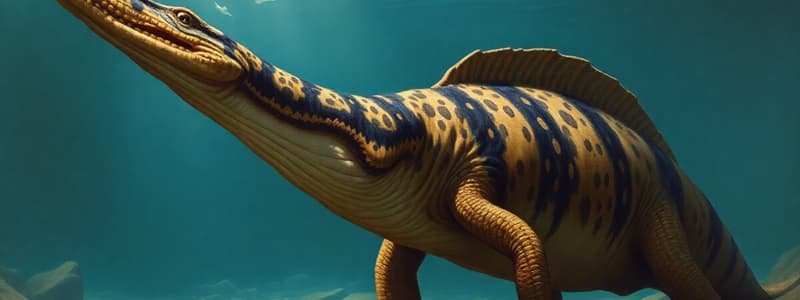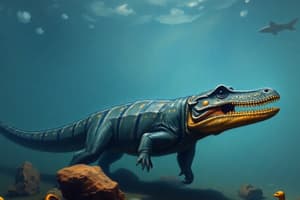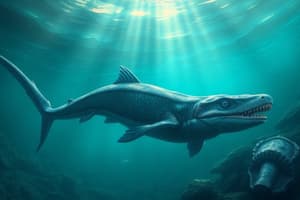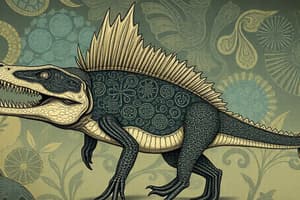Podcast
Questions and Answers
Why is the discovery of the new ichthyosaur species considered significant in the field of paleontology?
Why is the discovery of the new ichthyosaur species considered significant in the field of paleontology?
- It confirms the widespread distribution of ichthyosaurs across different geographical locations during the Triassic period.
- It challenges current understandings of ichthyosaur evolution and adaptation to marine environments, given its enormous size. (correct)
- It provides definitive evidence that ichthyosaurs were the dominant marine predators in a specific region during a specific time.
- It suggests a novel approach to fossil excavation involving collaboration between amateur paleontologists and professional researchers.
What critical step did Justin Reynolds take that significantly contributed to the scientific validation of his and Ruby's fossil discovery?
What critical step did Justin Reynolds take that significantly contributed to the scientific validation of his and Ruby's fossil discovery?
- He promptly contacted a marine reptile expert to examine the fossils, which facilitated professional analysis and identification. (correct)
- He meticulously cleaned and reassembled the fossil fragments, creating a near-complete reconstruction of the ichthyosaur jaw.
- He secured the discovery site to prevent any disturbance or removal of additional fossil evidence by other collectors.
- He conducted extensive research to compare the discovered fossil to other known marine reptile fossils, providing foundational evidence for its classification.
Considering the estimated size of the newly discovered ichthyosaur, what implications might this have for understanding the marine ecosystem during its time?
Considering the estimated size of the newly discovered ichthyosaur, what implications might this have for understanding the marine ecosystem during its time?
- It implies that the marine environment was undergoing a period of rapid climate change, favoring larger species better adapted to fluctuating conditions.
- It indicates the presence of a complex food web capable of supporting such a large predator, revealing insights into the abundance and diversity of marine life. (correct)
- It suggests a highly competitive environment where only the largest predators could survive, leading to an accelerated rate of evolution.
- It confirms the presence of advanced hunting strategies among marine reptiles, requiring larger body sizes to capture increasingly elusive prey.
The classification of a new ichthyosaur species was enabled by comparing remains from two separate discoveries. What does this suggest about the nature of paleontological research?
The classification of a new ichthyosaur species was enabled by comparing remains from two separate discoveries. What does this suggest about the nature of paleontological research?
How might the collaboration between amateur paleontologists and professional researchers, as seen in this discovery, influence future paleontological studies?
How might the collaboration between amateur paleontologists and professional researchers, as seen in this discovery, influence future paleontological studies?
Considering the discovery context on Blue Anchor Beach, what geological factors might have contributed to the preservation and exposure of these ichthyosaur fossils?
Considering the discovery context on Blue Anchor Beach, what geological factors might have contributed to the preservation and exposure of these ichthyosaur fossils?
If the newly discovered ichthyosaur is confirmed to be among the largest marine animals ever, what challenges does this present to our current understanding of the physiological limits of marine reptiles?
If the newly discovered ichthyosaur is confirmed to be among the largest marine animals ever, what challenges does this present to our current understanding of the physiological limits of marine reptiles?
Based on the information provided, what conclusions can be drawn about the completeness of the fossil record for ichthyosaurs and other large marine reptiles?
Based on the information provided, what conclusions can be drawn about the completeness of the fossil record for ichthyosaurs and other large marine reptiles?
Flashcards
Ichthyosaurs
Ichthyosaurs
Marine reptiles that lived during the Triassic and Jurassic periods, resembling dolphins and whales.
Triassic and Jurassic Periods
Triassic and Jurassic Periods
The time period from 251 to 145 million years ago, when ichthyosaurs dominated the seas.
Blue Anchor Beach
Blue Anchor Beach
The location in Somerset, England, where the ichthyosaur fossils were discovered.
Dr. Dean Lomax
Dr. Dean Lomax
Signup and view all the flashcards
80 feet (24 m)
80 feet (24 m)
Signup and view all the flashcards
Ichthyosaur Jaw
Ichthyosaur Jaw
Signup and view all the flashcards
New Ichthyosaur Species
New Ichthyosaur Species
Signup and view all the flashcards
Paleontologist
Paleontologist
Signup and view all the flashcards
Study Notes
- A father-daughter team discovered a new, massive species of ichthyosaur.
- Ichthyosaurs were marine reptiles that dominated the seas during the Triassic and Jurassic periods (251 to 145 million years ago).
- They are often referred to as "fish-lizards" due to their physical similarities to dolphins and whales, but they were reptiles.
- In spring 2020, Justin Reynolds and his 11-year-old daughter Ruby went fossil hunting on Blue Anchor Beach in Somerset, England.
- Blue Anchor Beach is known for its rich deposits of fish and reptile fossils from the Triassic-era.
- The pair discovered a four-inch (10 cm) long oval fossil, and Ruby found another piece of fossilized bone in the same area that was twice as big.
- Justin guessed that the bones were from an ichthyosaur, which was confirmed by Dr. Dean Lomax, a marine reptile expert at the University of Manchester.
- Dr. Lomax and his team invited the Reynolds to help find additional pieces of the fossil.
- By October 2022, they gathered enough pieces to reconstruct a section of the marine reptile's lower jaw.
- Analysis revealed that the jaw would have measured over six feet (1.8 m) long if complete.
- Scientists estimated the new specimen's length to be 80 feet (24 m), based on comparisons with other giant ichthyosaurs.
- This would make it one of the largest marine animals to ever live.
- The remains of the new specimen, along with another similar ichthyosaur found in 2016, allowed the scientists to classify it as a new species.
- The creature was named Ichthyotitan severnensis, meaning "giant fish lizard of the Severn."
- Ruby and Justin were listed as co-authors in the study published in the journal PLOS One on April 17, 2024.
- Ruby is now 15 years old.
Studying That Suits You
Use AI to generate personalized quizzes and flashcards to suit your learning preferences.





